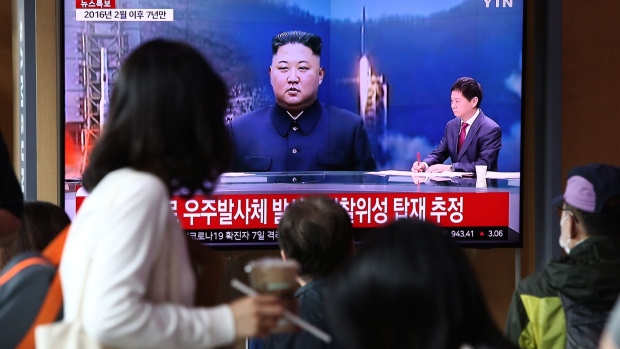Jul 11, 2023
North Korea Fires Ballistic Missile After Threat to US
, Bloomberg News

(Bloomberg) -- North Korea test-fired a long-range ballistic missile designed to deliver a nuclear strike on the US after warning Washington of “shocking” consequences for flying spy planes Pyongyang claimed violated its airspace.
The missile was launched Wednesday from an area near Pyongyang and flew for about 74 minutes before splashing down in waters west of Japan and outside of the country’s exclusive economic zone, according to authorities in Tokyo and Seoul. Japan’s Defense Ministry said the missile was an ICBM that reached an altitude of about 6,000 kilometers (3,730 miles).
North Korea’s ICBMs are the most powerful missiles in its arsenal and the test comes a day after Kim Yo Jong, the influential sister of the leader, was cited by Pyongyang’s state media as threatening retribution for the US flights.
“Because it’s an ICBM that is designed to target the US homeland, it appears North Korea is protesting the recent flights of US spy planes,” said Duyeon Kim, an adjunct senior fellow in Seoul at the Center for a New American Security.
South Korea Salvages North’s Satellite in Intelligence Win
She added North Korea may be looking to step up tensions ahead of the 70th anniversary later this month of the armistice that ended fighting in the Korean War. This could build domestic support after a rocket meant to put a satellite into orbit failed in flight in late May, and was salvaged by South Korea in international waters.
South Korea has denied that reconnaissance planes violated North Korean airspace. The US has flown the aircraft near North Korea for decades without incident, but in April 1969 North Korean jets downed a US Navy spy plane the Americans said was in international airspace between the Korean Peninsula and Japan, killing all 31 people aboard. It was one of the deadliest strikes by Pyongyang’s military after the end of the 1950-1953 Korean War.
North Korea’s last ICBM launch was in April when it tested a new solid-fuel rocket that would be easier to deploy and quicker to fire than its arsenal of liquid-fuel rockets — whose tanks take time to fill and make it vulnerable to being shot on the pad before taking off.
The ICBM fired Wednesday appeared to be a solid-fuel missile based on its flight trajectory and stage separation, Yonhap News Agency reported, citing a source it did not name.
The time it spent in the air could be the longest tracked for a North Korean ICBM and its apogee far exceeded the missile launched in April. This could indicate North Korea has increased the size of its solid-fuel ICBMs, which means they could carry a heavier nuclear payload to more parts of the world.
The latest launch draws attention to the threat posed by Kim Jong Un’s regime and coincides with a summit of NATO leaders in Lithuania, where the bloc is looking to step up its support for Ukraine.
NATO Summit
The leaders of Japan, South Korea, Australia and New Zealand are attending the North Atlantic Treaty Organization meeting to bolster awareness of security threats in the Asia-Pacific. South Korean President Yoon Suk Yeol and Japanese Prime Minister Fumio Kishida are expected to meet on the sidelines of the summit, with both leaders pledging to work with their US ally to prepare for contingencies from Pyongyang and pressure it to end its atomic ambitions.
The last time Kim Jong Un’s regime launched ballistic missiles was about three weeks ago when it fired two short-range rockets just minutes after threatening to punish the US for holding joint military drills with South Korea.
Prior to the latest launch, Pyongyang had fired 19 ballistic missiles and the space rocket so far this year, including three ICBMs. The country launched more than 70 ballistic missiles last year, a record for the state.
Kim Jong Un has ignored US calls to return to long-stalled nuclear disarmament talks. He has been busy modernizing his arsenal of missiles and conducting tests of systems to attack South Korea and Japan, which host the bulk of US military personnel in the region.
The US in June sent a nuclear-powered, guided-missile submarine to South Korea for the first time in six years in a show of force meant to deter North Korea from military strikes. South Korea’s president won assurances during a summit with President Joe Biden in April to strengthen extended deterrence measures, including more deployments of nuclear-armed submarines.
Displays of the US’s atomic assets are meant to serve as a reminder of a warning Biden issued to leader Kim during a meeting with the South Korean president that a nuclear strike by North Korea would be suicidal.
--With assistance from Ryotaro Nakamaru and Shinhye Kang.
(Updates with report on missile flight and its implications.)
©2023 Bloomberg L.P.





